Adam Yamey's Blog: YAMEY, page 27
January 15, 2025
An artist who depicts nature only naturally
AJIT KUMAR DAS was born in 1957, son of a laundry man (washer man). From an early age, he became fascinated with the wonderful colours of the textiles that his father washed. He became involved with traditional fabric printing and design. Today, Das is recognised as one of India’s foremost natural dye painters.
Das paints on cloth using natural dyes, rather than artificially created colours. He uses dyes derived ed from sources such as, for example, pomegranate rind, turmeric, fermented iron solution, indigo, and madder. He applies them using bamboo brushes and handmade quills. The colours are fixed using alum as mordant. With decades of experience and experimentation, he is able to use the natural dyes to produce interesting colourful effects.
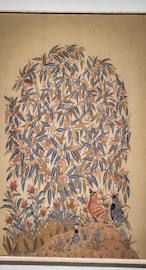
At his exhibition held in a magnificent gallery in the Kolkata Centre for Creativity, we were able to view more than 20 of his paintings. All of them feature closely observed natural objects, such as foliage, birds, and fish, all arranged in patterns on the textiles. Some of these compositions are naturalistic. In others, Das has arranged the details from nature to produce lovely patterns.
We were fortunate to have been at the inauguration of the exhibition, during which the soft-spoken Das discussed his works with a panel of invited guests. From what I could gather, the panellists were more interested in the current state of natural dye crafts than the artist’s works on display. I am pleased that we made the journey from central Kolkata to the outlying district of Anandapur to see the exhibition and to learn a little about the use of natural dyes in traditional methods of textile making.
January 14, 2025
A truly exciting and creative experience in a suburb of Kolkata
THE KOLKATA CENTRE for Creativity (‘KCC’) was established by the businessman Radhe Shyam Agarwal, executive chairman of the Emami Group. He commissioned architect Pinakin Patel to build the arts centre that stands in Kolkata’s Anandapur district. Inaugurated in late 2018, it has 70,000 square feet of floor space for art, artists, and art lovers. This includes an auditorium, gallery spaces, an elegant café, shops, a dance studio, and a library.
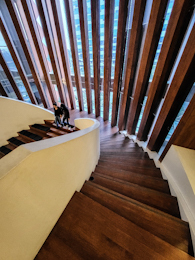
The building is a superb example of contemporary architectural design, both externally and internally. Inside, it is spacious and well-lit. The building, which serves its various purposes well, is in itself a work of art: a functional sculpture, one might say. We attended the inauguration of an exhibition, which was held in the auditorium, which forms part of the gallery space. I will describe the exhibition in another piece, but suffice it to say, the KCC, although distant from central Kolkata, is worth visiting.
January 13, 2025
An artist who works and lives in Kolkata
WHEN VIEWING ARTWORK or listening to music, my reaction to, and enjoyment of it is governed by my initial visceral feelings that it evokes. If these feelings are satisfactory, my interest and enjoyment of the art increases, and I might begin to delve more deeply into understanding what the creator is trying to convey with his or her work.
My initial reaction to the oil paintings and ink drawings by Kolkata based artist Debajyoti Roy were very positive. Each of his works on display appealed to me. Many of the images are in black ink on white paper. A couple of larger paintings were more colourful, created with oil colours and inks.
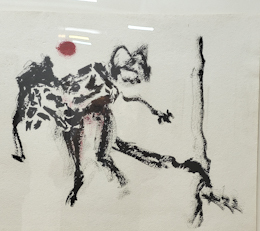
Some of the works in ink reminded me a little of Chinese or Japanese calligraphy. The works are both abstract and at the same time somewhat figurative. Yet, as I studied them, they gave me the feeling that they are abstractions of reality, often of biological phenomena. As Roy explained in the exhibition catalogue:
“When someone engages with a piece of art, it is inevitable to interpret its visual aspects. Still, the essence lies in deeper inquiries that provoke interpretation of the perception and reality.”
I felt that this was certainly the case with what I saw of his creations.
Debajyoti Roy has created a set of images that are intriguing both visually and intellectually. It is a shame that his exhibition at the Jogen Choudhury Centre for Arts in south Kolkata is ending soon (on 11 January 2025). If you happen to be in Kolkata before it ends, it is well worth viewing.
January 12, 2025
An evening prayer offering by the water of the River Ganges
THE WORD AARTI is from the Sanskrit language. It means ‘something that removes darkness’. In many pujas (Hindu ceremonies), an aarti is performed: it involves presenting a flame to appease the deity or deities.
One evening, we were walking along the bank of the Hooghly (a part of the holy Ganges river that flows through Kolkata) just after sunset. We came across rows of plastic chairs facing the river at Babughat (one of the stepped landings used by people bathing in the river). Between them and the water there was a row of altars. We asked someone the reason for the chairs. We were informed that they were set up so that people could watch the daily Ganga Aarti, which was due to happen at 530 pm. Our daughter, who had witnessed a Ganga Aarti at Varanasi, persuaded us to wait and watch the forthcoming aarti.
We sat down and joined the other spectators. While we waited, several hawkers walked along the rows of chairs, selling snacks of various kinds, both packaged and prepared to order (for example, jhal muri – puffed rice with flavourings). One hawker carried a tray on which a small lamp (a diya) was flickering. For a small cash offering, he blessed the ‘customer’ and placed some prasad (blessed food) into his or her right hand. Meanwhile, rotating spotlights and piped music added to the festive atmosphere. Gradually, all the seats were occupied, and many people were standing nearby on the sides of the ghat.
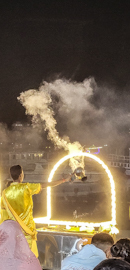
At 5.30 pm, priests dressed in shiny gold robes with wide sashes over their left shoulders began assembling, one in front of each of the altars. The latter were illuminated with hoops carrying brightly lit electric light bulbs. Then, the ceremony began.
A pandit, dressed in white, speaking into a handheld microphone chanted prayers in Sanskrit. As he was doing this, the gold clad priests performed several visually exciting activities. These included moving containers emitting clouds of smoke. They swung them and moved them in circles, each man in synchrony with the others. After this, they did much the same thing with candelabras each carrying many small flaming oil lamps (diyas). These were then replaced by larger flaming lamps, each of which had handles shaped like cobras ready to attack. After the balletic flame movements, the flaming lamps were carried down to the water’s edge. I could not see whether they were immersed in the river.
In addition to the movements with the flaming lamps, large conch shells were washed through with water, some of which was sprinkled on the crowd. The conches were also blown to produce a sound indistinguishable from the horns on the locomotives of the trains running every few minutes on the suburban railway track that was a few feet behind where the ceremony was being performed.
I am very pleased we waited to watch the Ganga Aarti. Apart from being more spectacular than many theatrical performances I have seen, it was very moving. It is yet another example of how much more vibrant and fervent religious ceremonies are in India than they are in most parts of Europe.
January 11, 2025
A mosque in south Kolkata and one of the heroes of India
THE TOLLYGUNGE CLUB in South Kolkata stands on land, which was once the home of members of the family of Tipu Sultan (1751-1799). He fought first the Marathas, and then the British valiantly until his death at Srirangapatnam. Had Tipu not been defeated, the British might have had great difficulty maintai g a foot in India.
Four years before Tipu’s death, his youngest son Ghulam Muhammad Sultan Sahib (1795-1872) was born in Srirangapatnam. In 1806, he and the rest of his family were deported to Calcutta by the British, and were settled in Tollygunge, south of the city. Where they lived is now occupied by the Tollygunge Club (founded 1895).
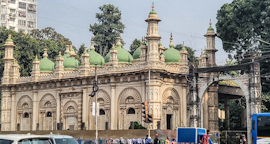
About 900 yards north of the Tollygunge Club’s clubhouse and across a very busy road, there is a mosque (on the corner of Deshparan Sasmal Road and Prince Anwar Shah Road). It stands within its own peaceful compound.
One of the first details I noticed when visiting the mosque and its grounds was that all of its outdoor lighting stands use old cannons for their bases. Maybe this is not surprising because this mosque is one of two in Kolkata named after Tipu Sultan. The Tollygunge Tipu mosque was constructed in 1860 by Tipu’s youngest son, Ghulam Muhammad Sultan Sahib. It is designed in the Indo-Islamic style. Its exterior is attractive, but its interior has very few visual attractions.
In the garden of the mosque, there is a raised rectangular platform. Upon this, there are five or six unmarked graves, each one looking dilapidated. One of these marks the burial place of Tipu’s youngest son. The walls of the platform have a few plaques engraved with words in a script resembling Urdu or Arabic. I was told that these words are of religious significance, rather than the names of the deceased.
At the east end of the compound, there are a few steps leading to a deep depression that was once a pond or small lake. An elderly caretaker told us that never in his long life had he ever seen water in it.
A review of the mosque on the TripAdvisor website described the place as not being somewhere in Kolkata that “must be seen”. This is correct, but as we often stay at the Tollygunge Club and have visited Srirangapatnam several times, I was keen to view the place with such an interesting link to Tipu Sultan.
January 10, 2025
Portraying the appearance and politics of Kolkata
ARTS ACRE IS an artists’ village on the Eastern edge of the city of Kolkata. When there is little traffic, it takes one hour of driving to reach it from the heart of old Kolkata. The Acre (aka International Centre for Creativity and Cultural vision) was founded in 1984 by the artist and cultural activist Shuvaprasanna Bhattacharjee (born 1947). The beautiful modernistic campus was designed by Partha Ranjan Das.
Today, the fifth of January 2025, we visited Arts Acre where several excellent exhibitions, part of the 2024/25 Bengal Biennale, were being held. One of these was a large show of paintings and other artworks by Shuvaprasanna. His wonderfully executed paintings reflect his interest in, and connection with, the politics of Bengal: he has been closely associated with the current Chief Minister of West Bengal, Mamata Banerjee. One of the paintings depict her as being like the pied piper of Hamelin. The artist wrote of this painting that just as the pied piper attracted his followers with the music of his pipe, Mamata attracts her followers by “… the mesmerising music of her leadership.” This painting was placed next to two others that seemed to be critical of the Communist regime that ruled Bengal for many years before Mamata and her Tfollowers Congress party were voted into power.
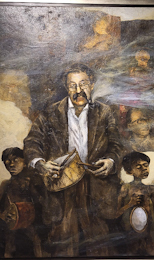 Günter Grass by Shuvaprasanna
Günter Grass by Shuvaprasanna Another picture relates to the visit to Arts Acre by the German author Günter Grass. Called “In search of Oscar”, the artist depicts Grass as Oscar in the novel “The Tin Drum”. The painting is supposed to evoke solidarity with the marginalised people in Kolkata.
Shuvaprasanna paints beautifully in ways that capture the ideas he is trying to convey in a highly accessible way, but without compromising artistic and aesthetic qualities.
It was worth spending an hour in a taxi to see Shuvaprasanna’s works and the art complex he established so many years ago.
January 9, 2025
Exhibits in an exhibition at a famous landmark in Kolkata
FROM AFAR, THE VICTORIA Memorial in Kolkata looks almost magical. However, inside it is pompous and overbearing (and not particularly beautiful), just as the British must have seemed to many Indians before their country was freed from the British Empire.
Visitors to the Memorial can explore the ground floor and the one above it. Much of the upper floor is dedicated to an exhibition of photographs and facsimiles of documents relating to the exploits of those who fought to make India independent. Naturally, better known individuals such as Gandhi, the Nehrus, and Subhas Chandra Bose figure in this show. But they are outnumbered by lesser known freedom fighters. One of these is Shyamji Krishnavarma (1857-1930). Many of you reading this might well be wondering why this man deserved to be includefacsimilesexhibition.
Like several other freedom fighters, Krishnavarma went to London to become a barrister. He returned to India and made a fortune working for the rulers of some of the Princely States. Then, he returned to London. In 1905, when Bengal was partitioned he conducted his own campaign against British rule in India.
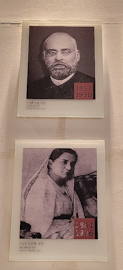 Above: Krishnavarma, below: Madame Cams
Above: Krishnavarma, below: Madame CamsAmongst the many things he did in addition to starting an anti-British newspaper, Krishnavarma purchased a house in Highgate (northwest London), which he converted into a hostel and meeting place for Indians studying in London. It was named India House. Soon, it became a meeting place for Indians who wanted to rid India of the British. I have read that amongst the revolutionary activities carried out in India House was experimentation in bomb making. Amongst those associated with India House was VD Savarkar (1883-1966). In 1910, he was arrested by the British and spent several terrible years in the Cellular Prison in Port Blair (Andaman Islands). Amongst Savarkar’s many achievements was the development of Hindutva.
In 1907, Krishnavarma migrated to Paris. Later, until his death he resided in Geneva. Unlike Gandhi and his followers, Krishnavarma and his colleagues (including Madame Cama) did not believe that India could become free by relying only on non-violent protest.
I first became interested in Krishnavarma when visiting Mandvi in Kutch (part of Gujarat). Shyamji was born in Mandvi, and his ashes are kept at a memorial centre a few miles outside the town. The centre includes a full size replica of Highate’s former India House. Seeing this building standing on its own in a flat sandy semi-desert landscape intrigued me, and got me interested in Krishnavarma. I became so fascinated that I wrote a book about Krishnavarma and what happened in and around his India House. The book is called “Indian Freedom Fighters in London (1905-1910)”, and is available from Amazon (e.g., https://www.amazon.co.uk/INDIAN-FREEDOM-FIGHTERS-LONDON-1905-1910/dp/0244270716/ ).
The exhibition at the Victoria Memorial includes several photographs and documents relating to Krishnavarma and his India House. I had seen some of these elsewhere, but a few were new to me.
Although the Victoria Memorial is not one if my favourite things in Kolkata, I am pleased we visited if only because there were exhibits related to Krishnavarma. In addition, I was pleased to see several paintings by Thomas Daniell (1749-1840) and one by an artist I like very much : John Zoffany (1733-1810). Both of these men spent several years living and working in India.
January 8, 2025
A peaceful place of rest in bustling Kolkata
IN ITS HEYDAY, the Jewish community of Kolkata consisted of as much as 6000 people. That was in the early 1940s. Today, less than about 20 Jewish people reside in the city. Most of Kolkata’s Jewish inhabitants were members of families that had migrated mainly from Iraq, but also from Syria. They were all Sephardic, rather than Ashkenazi, Jews. They began arriving in Kolkata in the very late eighteenth century. Most of Kolkata’s Jewish people have migrated to other countries – not because of anti-Semitism, but for economic reasons (as have many other Indians of all religions).
One can get an idea of the size of Kolkata’s Jewish community of yesteryear by visiting the Jewish Cemetery on Narkeldanga Main Road. It contains at least 2000 gravestones. We visited it on New Year’s Day 2025.
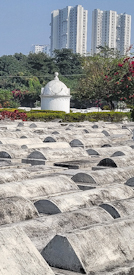 The genizah standing amongst the gravestones
The genizah standing amongst the gravestones The cemetery is beautifully maintained. Flowering bushes, trellises, and trees punctuate the sea of white gravestones. According to Sephardic tradition, the stones are horizontal, rather than vertical. Most of them consist of a rectangular base surmounted by a hemi-cylinder. Each grave bears the name of the deceased in Hebrew and/or Latin script. It seemed to me that all of the graves are oriented in the same direction: roughly speaking the long axis of each grave runs in an east/west direction (more accurately, the west end of each gravestone is slightly north of the east). The majority of the gravestones are simple, without ornament. A few of them are ornamented often with a stone carving of an open book.
Several of the stones record the deaths of military service personnel, who died in action. Notices on these record that the bodies of these people were buried in military cemeteries elsewhere, at Ranchi.
In the centre of the gently undulating burial ground, there stands a circular tower, which is higher than all of the other graves. The tower, looking a bit like an enlarged pillar box (letter box). has a rectangular opening like that found on post boxes. This structure is a genizah.
A genizah is a place for disposing of worn out or no longer required sacred texts. These can include any documents that contain the name of God. These can be anything from holy texts to commercial contracts, legal documents, and personal letters. If you wish to know more about the contents of a genizah, you could do well to read “In an Antique Land” by Amitabh Ghosh. I have read this autobiographical novel that includes much about a very ancient genizah discovered in Cairo, and was very excited to see a real genizah in Kolkata.
I am not sure how easy it would have been to visit this fascinating Cemetery – a record of a once thriving community – had we not known one of Kolkata’s few remaining Jewish inhabitants. Mentioning this person’s name persuaded the security officials to allow us to enter.
January 7, 2025
A goddess and going to jail in Kolkata
THE ALIPORE JAIL used to house political prisoners, whom the British regarded as a threat to their rule of India. The inmates included freedom fighters such as the future Sri Aurobindo, Jawaharlal Nehru, and Subhas Chandra Bose. The prison has been restored and is now a museum. In December 2024 and for the first few days of 2025, several exhibitions that are part of the Bengal Biennale have been held in some of the jail’s buildings. One of these, which I found extremely interesting and well curated, is called “Kali: Reverence and Rebellion”.
Kali is a Hindu goddess. I will not try to explain her exploits and great importance to Hindus, but will outline the subject matter of the exhibition by quoting from the website of the Biennale (www.bengalbiennale.com/):
“Divided into sections, the exhibition traces Kali’s pervasive influence across the subcontinent. It explores Kali and her cohorts of the divine feminine. Born from Durga’s angry, darkened brow as she battles the asuras Chanda and Munda, Kali decapitates the demons and assumes the form of Chamunda. Within these depictions, she is seen alongside Durga, the primordial force, as well as the ten Mahavidyas that emerge to subdue Shiva.”
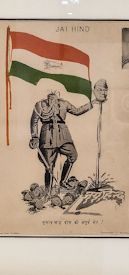 Subhas Chandra Bose image
Subhas Chandra Bose imageIn addition to the wonderful array of images on display, which can be enjoyed without any knowledge of Kali, what fascinated me was the connection between Kali and the fight of Indians for independence. The website explained:
“During the nationalist period, Kali was invoked as a symbol of rebellion by Aurobindo Ghosh and Subhash Chandra Bose to urge their followers to fight against imperialist forces.”
In connection with this, two images fascinated me. One of them depicts Kali who has cut off her own head and she holds it in her left hand while blood shoots out of her cut neck and into the mouth of her self-decapitated head. Painted in about 1840, this image shows what Kali did after either she was unable to obtain Shiva’s blood, or she had been deprived of her conjugal rights. Known as Chinnamasta, this avatar of Kali is often shown with one foot on the chest of a god (Shiva) or standing above a copulating couple.
Elsewhere in the exhibition, there is an image of Subhas Chandra Bose created during the twentieth century. It shows the freedom fighter, Bose, standing decapitated and holding his own head in his left hand. He is standing above a group of decapitated heads. Blood pours down from his head and it falls onto a map of India on which the words “Jai Hind” (‘Victory to India’) can be seen. The image is a politicisation of the depiction of Chinnamasta.
Apart from a wonderful selection of Kali images created by Indian artists, there are a few made by early Europeans who visited India and wanted to record their experiences and to attempt to understand Hinduism. All in all, the exhibition was very well worth viewing. It was so popular with visitors to the jail that a security guard was present to regulate the number of viewers at any one time, to prevent overcrowding.
January 6, 2025
Chikkamma Tours (Pvt.) Ltd: a detective story set in Bangalore
THIS BOOK WAS RECOMMENDED to me by a bookseller in Bangalore, at Bookworm, because she said that the shop is mentioned in the book. In the novel, Chikkamma Tours is a small travel company located beneath a bookshop run by Jagat Desai. One night, he is murdered. His body is found the next morning by one of the ladies who work in the office beneath the bookshop. The police are informed, but the three women who work at Chikkamma Tours decide to make their own investigation of the murder. What they discovered about themselves and the crime are the subjects of this ‘whodunnit’ novel.
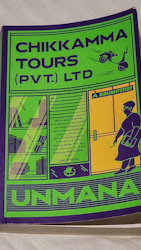
Although I enjoyed reading it, this book is not a great work of literature. However, it was fun and I liked it because it captures many aspects of life in a city I visit frequently: Bangalore. As I proceeded through it, I recognised many things I know about the city and, especially, its bookshops.
Would I recommend this book? I would to Bangaloreans and to people who know the city well. However, I am uncertain that it would appeal to those who have little or no connection with the city. That said, I am pleased that the lady at Bookworm suggested I should read it.



